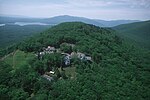Olive and Hurley Old School Baptist Church
1808 establishments in New York (state)19th-century Baptist churches in the United StatesBaptist churches in New York (state)Churches completed in 1857Churches in Ulster County, New York ... and 3 more
Churches on the National Register of Historic Places in New York (state)National Register of Historic Places in Ulster County, New YorkUse mdy dates from October 2011

Olive and Hurley Old School Baptist Church is an historic Baptist meeting house on NY Route 28, at the junction with Ulster County Route 30 in Shokan, New York. It was built in 1857 and added to the National Register of Historic Places in 1998.
Excerpt from the Wikipedia article Olive and Hurley Old School Baptist Church (License: CC BY-SA 3.0, Authors, Images).Olive and Hurley Old School Baptist Church
State Route 28, Town of Olive
Geographical coordinates (GPS) Address Nearby Places Show on map
Geographical coordinates (GPS)
| Latitude | Longitude |
|---|---|
| N 41.973333333333 ° | E -74.2125 ° |
Address
State Route 28 3196
12481 Town of Olive
New York, United States
Open on Google Maps






